A faint and small constellation of the southern sky, which is always hidden below the horizon in our latitudes. It lies to the south of Scorpio, Sagittarius and the Corona australis, so it understandably does not stand out much in the sky. In the constellation we find a few faint galaxies, a globular cluster and a small planetary nebula. Curiously, the constellation today lacks γ Telescopii, which has become G Scorpii in cusp of Scorpius, so that the current version of the celestial telescope is considerably shorter than N. L. Lacaille's idea.
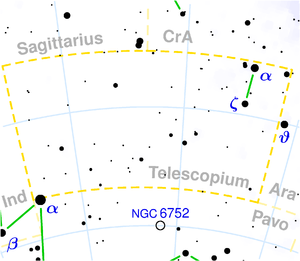
α Tel - The brightest star of the constellation has a magnitude of 3.76. It is a blue-white star of spectral class B3, located 249 light-years away from us.
ε Tel - A binary star composed of a primary component with a brightness of 4.5 magnitude and a faint companion with a magnitude of 13, which is located at a separation of 21". The components are separated by 410 light-years.
δ Tel - An optical binary star easily distinguishable with the naked eye. It consists of components with brightness of 4.9mag and 5.1mag, located at a distance of 800 and 1,100 light years.
RR Tel - Although this star is too faint for a small telescope, it is one of the most interesting novae recorded in our history. Before 1945, its brightness fluctuated between 12.5 mag and 15 mag. However, it then flared up and maintained a brightness of 6.5 mag for 5 years. Although it later faded back to its original brightness, it still retained its original period of brightness changes. It is definitely a binary star, with the larger component being a red giant that varies in brightness, while the smaller component is a hot dense star that flared up as a nova.
NGC 6584
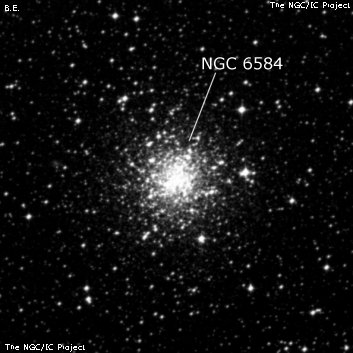
James Dunlop discovered NGC 6584 = D 376 = h3737 on 5 Jun 1826 and described a "pretty bright round nebula, about 1 1/4' diameter, moderately condensed to the centre; three very small stars involved in the preceding margin." He claims 4 observations and his position is 6.5' due west of center. John Herschel made two observations, first recording on 8 Jul 1834, "globular cluster; B; R; gmbM; entirely resolved into stars 16m; easily seen."
200/250mm - 8" (7/13/91 - Southern Baja): moderately bright, fairly small, 3' diameter, round, broad concentration to core. Slight resolution at edges and three brighter field stars are off the NW, west and SW sides. Observed at 14° elevation from Baja.
400/500mm - 18" (7/9/02 - Magellan Observatory, Australia): at 171x this globular appeared fairly bright, moderately large, ~4' diameter with a broad concentration and a fairly symmetric appearance. It was resolved into a couple of dozen faint stars, mostly in the halo, which appeared a bit ragged. The central core was very mottled but unresolved. A few brighter mag 11 stars are just outside the halo, but these appeared to be foreground stars. A mag 7.5 star is 13' NW and mag 7.0 star 15' NNE. Located 2.8° SE of mag 3.7 Theta Arae at a distance of ~45,000 light years in the inner halo.
Notes by Steve Gottlieb
NGC 6868
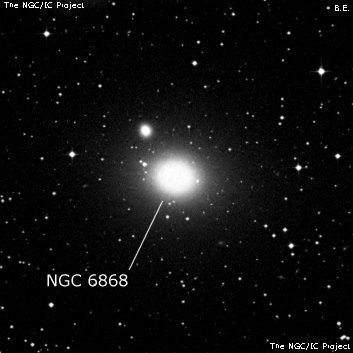
John Herschel discovered NGC 6868 = h3814 on 7 Jul 1834 and recorded "vB; S; R: pgmbM; 20"."
Pietro Baracchi discovered 2MASX J20095889-4821262 off the NE edge, as well as nearby ESO 223-035, while observing NGC 6868 on 5 Oct 1885 with the Great Melbourne Telescope. He noted "[NGC 6868] has a small nebulous spark n.f. (See diagram). Faint, small, flat." "Flat" indicates an even surface brightness.
200/250mm - 8" (7/13/91 - Southern Baja): fairly faint, fairly small, slightly elongated 4:3 N-S, bright core. Pair with NGC 6870 6.2' NNE and brightest with NGC 6861 in a group.
400/500mm - 18" (7/10/02 - Magellan Observatory, Australia): this giant elliptical is one of the brightest members of the Telescopium Group (ACO S851), at a distance of roughly 120 million light-years. At 128x, NGC 6868 appeared moderately bright and large, slightly elongated E-W, ~1.5'x1.2'. Contains a bright core that is concentrated to the center. Forms the southern vertex of an equilateral triangle with members NGC 6870 6' NNE and ESO 233-035 7' NW.
600/800mm - 30" (10/18/17 - OzSky): at 429x; this giant elliptical is the brightest member of the Telescopium Group = ACO S851. It appeared very bright, fairly large, slightly elongated 5:4 WSW-ENE, ~1.8'x1.5' sharply concentrated with an intensely bright core that increases to the center, halo gradually fades. 2MASX J20095889-4821262 is off the NE edge, 1.6' from center, and was fairly faint to moderately bright, round, 20" diameter, weak concentration, with a fairly high surface brightness. NGC 6770 lies 6.3' NNE, ESO 233-035 7.4' NW and NGC 6861F (faint edge-on) 14.5' NE.
Notes by Steve Gottlieb
NGC 6845
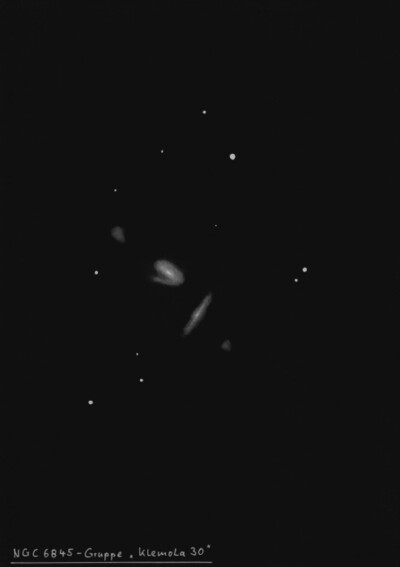
NGC 6845B required averted vision and appeared extremely faint and small, round, 0.3' diameter, very low surface brightness. NGC 6845C appeared very faint, small, very elongated 4:1 NW-SE, 0.6'x0.15'. On the DSS image, faint tidal plumes appear to connect NGC 6845A with this companion.
John Herschel discovered NGC 6845 = h3803 on 7 Jul 1834 (sweep 467) and recorded "eF; lE; glbM; 30"." In a second observation he logged "vF; R; bM; 15". Found and viewed by the place of sweep 467." This is a compact interacting group of four galaxies (Klemola 30) and RC3 identifies the brightest member as NGC 6845A.
The entire quartet was found during an examination of Bruce plates taken at Arequipa, Peru between 1908 and 1913. The individual members were catalogued in a list by Solon Bailey of 1659 new nebulae in the 1913 Annals of the Astronomical Observatory of Harvard College, Vol. 72.
400/500mm - 18" (7/10/02 - Magellan Observatory, Australia): this is the brightest component of a compact interacting quartet. At 128x it appeared fairly faint, fairly small, oval 3:2 SSW-NNE, 1.0'x0.7', very weak concentration. Two companions are resolved - NGC 6845B at 1.4' NE (at the end of a long tidal tail) and NGC 6845C at 0.8' SW.
600/800mm - 25" (10/21/17 - OzSky): at 244x and 397x; NGC 6845A is the largest member in this compact interacting quartet, in a southwest/northeast string. It appeared moderately bright, elongated ~4:3, only a broad weak concentration. The shape was noticeably curved or irregular on the southwest side. Images show this is the root and beginning of a tidal arm that curves east and connects to NGC 6845B. Located 9.6' SE of mag 8.8 HD 189059.
NGC 6845B, just 1.4' NE, appeared very faint, very small, slightly elongated, 15"-20" diameter. NGC 6845C, centered 0.9' SSW, appeared fairly faint, fairly small, very elongated 4:1 NW-SE, 40"x10", small bright core, fairly high surface brightness (highest of the quartet). NGC 6845D, 1.8' SW, appeared extremely faint, elongated NNW-SSE, ~15'x10" NNW-SSE, requires averted.
Notes by Steve Gottlieb
IC 4699
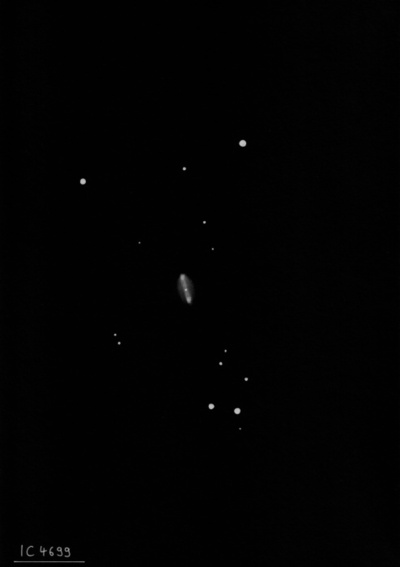
Williamina Fleming discovered IC 4699 = Fleming 98 on a Harvard objective prism plate taken in 1901 at the Arequipa station.
300/350mm - 13.1" (7/12/86): at 79x and 166x appears very faint and stellar. Verified with both OIII and UHC filters. Estimate V = 13.0 but may be brighter due to the very low elevation of object from Northern California. Uncertain if a very small disc was visible at 166x or bloated due to seeing this close to the horizon. Located 3.5' NW of mag 8.8 HD 167758 and nearly at the midpoint between mag 4.5 Epsilon and mag 3.5 Alpha Telescopii (the two stars are 2.7° apart).
Notes by Steve Gottlieb